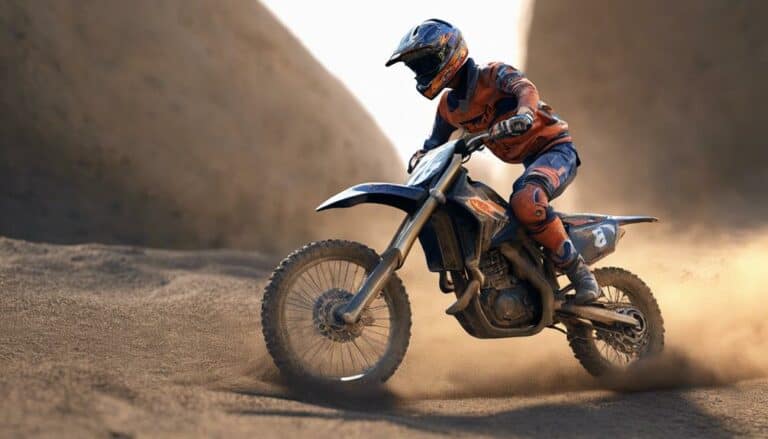When exploring the twists and turns of dirt trails, your body becomes the compass guiding the effectiveness of your braking maneuvers. Every shift in weight, angle of lean, and grip on the bike can dictate the outcome of your braking performance.
But how exactly does your body positioning impact this important aspect of dirt biking? Let's uncover the secrets behind maximizing braking effectiveness through strategic body placement and movement on your two-wheeled adventure companion.
Key Takeaways
- Proper body positioning optimizes braking control and stability on a dirt bike.
- Weight distribution affects braking efficiency, with a balanced stance maximizing control.
- Leaning back enhances rear brake effectiveness and traction during deceleration.
- Precision braking is achieved through strategic body dynamics and maintaining a balanced posture.
The Role of Body Positioning
Proper body positioning on a dirt bike greatly enhances braking effectiveness by optimizing control and stability. When approaching a braking situation, ensuring your body is in the right position can make a significant difference in your ability to handle the bike.
By shifting your weight slightly back and standing on the footpegs, you allow for better weight distribution, which in turn improves braking control. Focusing on keeping your elbows up and pointing your toes in will assist in maintaining balance and control, especially when engaging the front brake. This technique helps prevent the front wheel from locking up and allows for more precise braking maneuvers.
Lowering your center of gravity through correct body positioning increases stability, particularly when using the brakes aggressively. Changing smoothly between sitting and standing positions is important as it optimizes braking performance on various terrains, ensuring you have the necessary control and stability to handle any braking situation effectively.
Weight Distribution and Braking
Optimizing weight distribution plays an important role in enhancing braking performance on a dirt bike. When considering weight distribution for braking, it's critical to focus on both the front and rear wheels to achieve best results.
- Rear Wheel: Leaning slightly back while braking shifts more weight onto the rear wheel. This extra weight increases traction on the rear wheel, providing better stability and preventing the rear from skidding out.
- Front Wheel: While shifting weight to the rear is important, maintaining some weight over the front wheel is also essential. This helps in maintaining steering control and prevents the front wheel from washing out during hard braking.
- Body Position: Centering your body weight over the bike's center of gravity ensures a balanced weight distribution between the front and rear wheels. This balanced distribution maximizes braking efficiency and control, allowing for smoother and more effective stops.
Optimizing Body Posture for Braking
Shifting your body weight back slightly while maintaining control over the bike's steering is vital to optimizing braking performance on a dirt bike. By leaning back, you enhance the effectiveness of the rear brake and improve traction on the rear wheel, allowing for better control and stability during braking. This riding technique is essential for ensuring that you can stop efficiently without losing balance or risking accidents.
To further illustrate the importance of optimizing body posture for braking, let's look at the following table:
| Riding Technique | Impact on Braking Performance |
|---|---|
| Leaning back slightly | Improves rear wheel traction |
| Keeping elbows up | Enhances control and maneuverability |
| Engaging core muscles | Aids in absorbing braking forces |
Body Lean and Braking Efficiency
Leaning your body appropriately while braking impacts the efficiency of your dirt bike's braking performance. When you lean your body forward, you shift weight to the front end of the bike, increasing traction and enhancing braking efficiency. This action helps the front wheel grip the surface better, allowing you to stop more effectively.
Additionally, maintaining proper body positioning, such as leaning back slightly, can prevent the bike from nosediving during hard braking, ensuring stability and control throughout the maneuver.
- Leaning forward shifts weight to the front end, improving traction and braking effectiveness.
- Proper body positioning prevents nosediving and maintains stability during hard braking.
- Balanced body posture with knees gripping the bike enhances control and responsiveness, optimizing braking efficiency.
Precision Braking Through Body Dynamics
Enhancing your dirt bike's braking precision relies heavily on the dynamic adjustments your body makes during the braking process. By mastering the art of body positioning, you can achieve best weight distribution for efficient braking.
When braking, guarantee your body is positioned correctly to transfer weight to the front wheel, maximizing traction and stopping power. Leaning back slightly can enhance rear tire grip, providing stability during deceleration. Keeping your elbows up and distributing your weight evenly help in maintaining control over the bike while braking.
Lowering your center of gravity through strategic body movements allows for better handling and improved braking control. Engage your core muscles and maintain a balanced stance to optimize braking effectiveness. Remember, mastering these body dynamics is essential for honing your riding skills and achieving precision in braking on your dirt bike.
Conclusion
In summary, your body positioning on a dirt bike is like a conductor leading an orchestra – every movement plays a vital role in the symphony of braking effectiveness.
By mastering the attack position, weight distribution, and body dynamics, you can fine-tune your braking performance to achieve peak control and stability.
Remember, your body is the key to unleashing the full potential of your dirt bike's braking capabilities. Keep practicing and refining your technique to become a master of the dirt bike domain.

